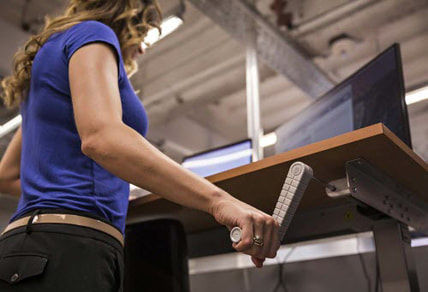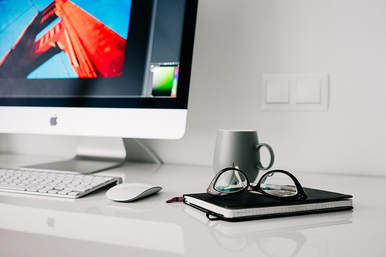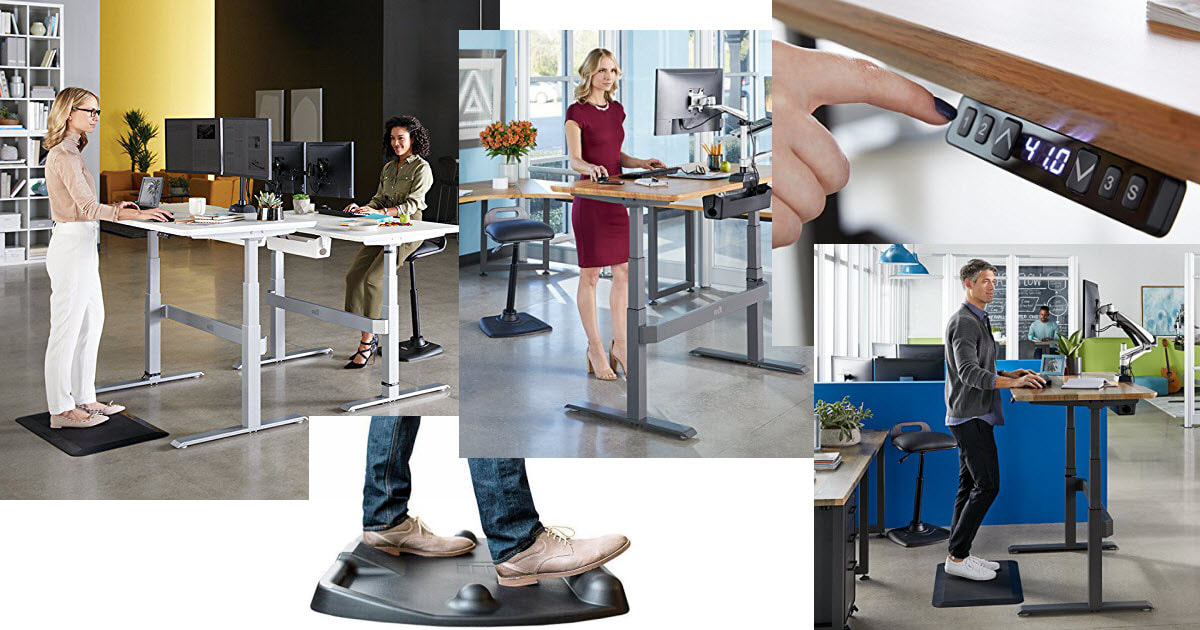Standing Desk Posture Tips & Best Practices
By now, you’ve probably heard you should be standing at your workstation for at least 15 minutes per hour. While standing at your desk is unlikely to help in combating weight gain in an office position, it is beneficial to reduce the risk of shoulder, neck, and lower back pain. If you have decided to make the switch from sitting all day, here are some tips and best practices to using a standing desk.
If you are switching to a standing desk, there are a few things I absolutely recommend. An excellent anti-fatigue mat (this is my favorite), a gas-spring monitor mount arm so you can easily re-position your monitor as needed (like this one), and you also might consider an adjustable-height standing desk stool (like this one) to help you keep moving, even when you need a break at your new active workstation.
An Adjustable Sit to Stand Desk is Important
Some people feel that it may be cheaper to simply add a standing table or a counter to their work space or office, but investing in a desk that can be adjusted in height is good for a couple of reasons.
First, the transition period isn't easy for everyone. When you go from sitting all day to standing all day, your body might protest. Your feet won’t be use to the weight on them all day, you might feel fatigued, and when it comes down to it, the idea of sitting will become more and more inviting. To avoid back-sliding or injuring yourself from the sudden lifestyle transition, start by standing 15 minutes every hour. When this becomes easy, add an extra 5 minutes of standing time. Keep doing this until you reach standing for the full hour. Eventually you'll want to find a balance between standing and sitting, usually something like 45 minutes up, 15 minutes down works for most people as a way to keep moving, alleviate pain caused by sitting, but also to finish your work day feeling energized rather than drained. Second, investing in an adjustable height desk or a quality standing desk converter will help you to dial in proper ergonomics at your desk, both when standing and when sitting. Getting a standing desk won't help you unless you pay close attention to the height of your desk, and being able to fine-tune the sitting desk height may help you alleviate a lot of your pain as well. In my view, a height-adjustable desk can be a great benefit ... even if you plan to continue sitting at work. How to Use a Standing Desk: Standing Desk Posture Tips
When using a standing desk, or whenever you’re standing, maintaining correct posture is important to avoid excessive strain on your postural muscles.
If you’ve been sitting for years, then chances are your postural muscles already have problems. Don’t worry. These can be corrected quickly, and maintaining correct posture at your standing desk moving forward will help to prevent postural muscle problems from happening again. (I am not a doctor, and this is not medical advice. If you have severe postural muscle issues seek out advice from a qualified physician) To maintain correct standing desk posture and get the most out of your new desk, you’ll want to bear your weight primarily on the balls of your feet, keeping your knees slightly bent. Set your feet about shoulder-width apart. To align your shoulders properly, let your arms hang to your side and roll your shoulders back until your thumbs are facing forward. You’ll want to keep your head level, stomach tucked in, and then shift your weight from one foot to the other as you stand for long periods at a time. Consider investing in a footrest, high quality standing desk mat (and once you've been at it for a while, you may find a standing desk balance board to be even better). You’ll vary between three positions with this. First, both feet on the standing desk mat. Second, one foot on the footrest. Third, switch which foot is on the footrest. You’ll then start back at the first position, both feet on the ground. In the early going set a timer on your phone to remind you to switch between these positions on a regular schedule. This will help to keep you moving and create good habits for your new active workstation. Standing Desk Mistakes to Avoid
When you try anything new, there's always the chance that you'll do it the wrong way at first. When it comes to how you stand, sit, and move, this can quickly result in injury.
In an effort to help you avoid bad habits and injury, we've rounded up a few of the most common stumbling blocks and standing desk mistakes that are easily avoidable. Go through this quick checklist and make sure you're not falling into any of these traps that can result in pain, injury, or bad posture and you're more likely to have a successful transition to your new standing desk.
Final Thoughts on Learning How to Use a Standing Desk
One of the reasons people have a bad transition to working at a standing desk is because they try too much, too soon. Take your time and plan a 1-2 week transition period to reach the standing/sitting balance you hope to achieve. Don't expect overnight relief from pain. Transitioning to a standing desk should be approached like any lifestyle change. It's not a fad diet or a magic pill, but the research confirms that sitting less and moving more during your work day is a healthier alternative to sitting all day.
When you're ready to make your transition to a standing desk I hope you'll check out my list of the Top 10 Standing Desk Options This Year, and if you're in the market for a desktop riser, before you drop a lot of money on that one you've seen advertised on TV, check out my list of The Best Varidesk Alternatives (which are cheaper and, in some cases better). This one is my favorite.
2 Comments
Your comment will be posted after it is approved.
Leave a Reply. |
|
© COPYRIGHT 2020. ALL RIGHTS RESERVED.
|
10DESKS.COM IS a participant in the Amazon Services LLC Associates Program, an affiliate advertising program designed to provide a means for us to earn fees by linking to Amazon.com and affiliated sites. Read Our ADVERTISING Policy

